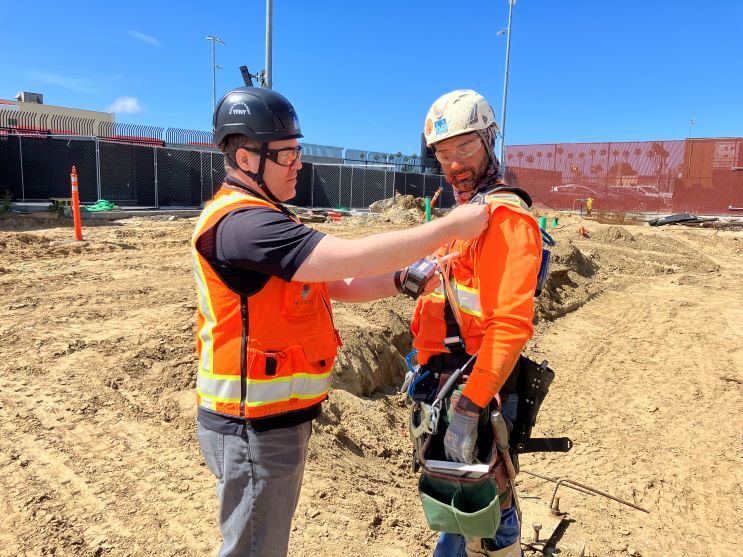CONTROLLING UNSEEN HAZARDS AS A CERTIFIED INDUSTRIAL HYGIENIST
Using the science of safety, Industrial Hygienists help keep workplaces safe and healthy from invisible threats.
By Jason Stoberl, Corporate Environmental and Industrial Hygiene Manager
What is Industrial Hygiene?
The American Industrial Hygiene Association (AIHA) defines industrial hygiene as ŌĆ£a science and art devoted to the anticipation, recognition, evaluation, and control of those environmental factors or stresses arising in or from the workplace, which may cause sickness, impaired health and well-being, or significant discomfort among workers or among the citizens of the community.ŌĆØ Simply put, industrial hygiene puts the ŌĆ£EŌĆØ and ŌĆ£HŌĆØ in Environmental, Health, and Safety Programs.
Industrial hygienists use various tools to quantify worker exposure to hazards from solvents, airborne particulates such as dust, noise, extreme heat or cold, ergonomics, and others. Certified Industrial Hygienists (CIHs) are a rarer breed. As of March 2024, there are only 6,659 CIHs globally, and about 40% of those professionals practice in the United States in industries and sectors ranging from manufacturing to research laboratories, hospitals, mining operations, government, and academia.
The CIH credential serves as a benchmark standard for measuring the skills and knowledge of industrial hygienists. For me, the CIH credential not only proves my commitment to the profession, but also provides evidence of upholding industry standards. It also lends credibility to ├█č┐┤½├ĮŌĆÖs commitment to be the premier builder in every market we serve.
├█č┐┤½├Į doesnŌĆÖt keep me on staff for bragging rights, though. My efforts and expertise directly contribute to worker safety and driving project quality and cost savings. In 2023 alone, direct cost savings using in-house CIH services surpassed seven figures.
For example, on a high-rise project in Downtown San Francisco, the freak combination of a trade partnerŌĆÖs schedule delay with historic rainstorms in January 2023 led to large-scale water intrusion and damage to interior drywall. While some damage was visible, water also seeped into the wall cavities, breeding mold. There was a significant possibility our self-perform Drywall group would have to tear out and replace all the drywall, causing a cascade of further schedule delays to the project.
I worked with the project team to do indoor air quality sampling to test for mold spores, as well as cutting out sections of drywall for moisture testing, ultimately determining which areas remained sound, and which areas needed replacing. Due to these efforts, we were able to remove and replace damaged drywall, but also retain that which was undamagedŌĆöall while keeping to the schedule.
In addition to testing for hazards on projects and training ├█č┐┤½├Į teams in best practices for industrial hygiene, I review Environmental Reports and Building Inspection Reports to ensure projects are in compliance before they begin. These documents are crucial for ensuring projects meet the Environmental Protection AgencyŌĆÖs requirements for assessing environmental risks such as asbestos and determining whether remediation may be required. My review can save clients schedule delays and avoid unexpected fines by reading and understanding the fine print.
Looking to the future, IŌĆÖm currently training teams across the ├█č┐┤½├Į nation in our industrial hygiene servicesŌĆöIŌĆÖve already conducted six trainings so far this yearŌĆöincluding focused discussions on Hazardous Materials and Environmental Site Assessment reports. As regulations and requirements evolve and change, it is crucial that teams stay informed to bid, plan, and perform all their work safely and effectively.
The Journey to Becoming an Industrial Hygienist
Like most children, I did not dream of being a Safety Professional, much less an Industrial Hygienist. While I knew that safety is very important, the fact it could be a rewarding technical career track wasnŌĆÖt on my radar growing up in rural Iowa.
Initially, I thought I would go to college to be an architect, but I quickly realized it wasnŌĆÖt for me. However, one of the required courses for architecture students at Iowa State University was in occupational safety, and that class changed the course of my career. Studying occupational safety meant defining and measuring optimum safety effectiveness for people, materials, equipment, methods, and environments. Basically, it was the science of safe workplaces, and I was hooked.
Since then, my career has shifted between consulting for a small industrial hygiene firm, adapting to the fast and furious pace as a Division Safety Manager for an electrical contractor in San Diego, and then to ├█č┐┤½├Į, where my scope and responsibilities increased as Safety Manager on a joint venture high rise in Downtown Los Angeles, and then as the Division Safety Manager for Orange County.
Throughout these roles, staying up-to-date on industrial hygiene practices related to jobsite safety has been one of my passions, and itŌĆÖs made a big difference at ├█č┐┤½├Į. In 2017, I received my professional Certified Industrial Hygienist designation, and I began developing ├█č┐┤½├ĮŌĆÖs silica mitigation program to reduce the hazards and lung damage related to airborne particles and debris.
In 2019, ├█č┐┤½├Į recognized my role as Industrial Hygienist with a dedicated position, meaning I can work with our business units nationwide to train them and provide specialized project support. Around the same time in 2019, I am proud to say I earned my masterŌĆÖs degree with high honors in industrial hygiene from Montana Technological University. These achievements help bring together my passion for construction workplace safety with the latest research and techniques to ensure that safety.
Jason Stoberl supports project teams as ├█č┐┤½├ĮŌĆÖs in-house Certified Industrial Hygienist certified by the Board for Global Enrivonmental Health Services Credentialing. He also holds the Certified Safety Professional (CSP) designation from the Board of Certified Safety Professionals.



